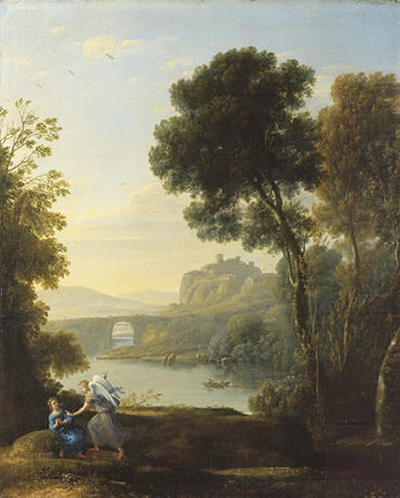Hagar and the Angel brings together all of the signature elements that make up the artistic style used by Claude throughout his career. It remains one of his most famous paintings and today resides in the permanent collection of the National Gallery in London, UK.
The artist would always provide interest in both the foreground and background, with any figures placed in the former. Here we find the two figures in conversation on a grassy bank, looking down on a sprawling landscape which is viewed through a gap in the trees. Heavy shadows fall around due to the tall trees which line both sides of the painting, though with brighter tones showing through at the back. Claude allows just a little light to fall upon the angel's wings, in order for the viewer not to miss this important detail. Looking through the space between this thick, dense forest, we then see a mass of water leading up to a bridge, with a city then found atop a mountain to the right hand side. It feels romantic, as if the artist has perfected his view to make it superior even to reality and this is something the artist was known for. In the river below we see a small boat making its way across the horizontal of the painting, which was another common addition used by Claude Lorrain.
Within this scene, the angel speaks to Hagar and helps her to find food and water. Hagar had been expelled earlier and had found herself in trouble after travelling through the wilderness. Religious and mythological writings will often give stories of where an angel or other figure will appear to give guidance and save someone from their tribulations. Claude possessed the artistic ability to take a passage of text and bring it to life in a visual way, helping others also to learn and remember this particular story. Artists would always rely on a dominant display of wings to signify an angel, whilst here Hagar is pictured in a relatively simply blue outfit. Her hands are in the pray position as she calls out for guidance during this troubled time. The style of Claude almost places two artworks together in one, as the majority of the landscape behind is relatively unconnected to the figures in front, other than the city which the angel points towards.
For those looking to see more variants of this consistent style, some of the artist's other famous paintings included A Seaport at Sunrise, Landscape with Psyche Outside the Palace of Cupid and Landscape with Cephalus and Procris Reunited by Diana. Architecture played an important role in some of his artworks, but there were also many like Hagar and the Angel in which nature and the rolling hills of Italy would dominate his mind. Claude would not always mention Italy within these scenes, but the influence from his time living in Rome is known to have impacted his choices of trees and other natural species. He would therefore merge classical literature and biblical themes with elements of the present, and would continue this approach throughout a highly successful career. He also remains regarded as a critical contributor to the evolution of landscape art into a respected, specialist genre.




